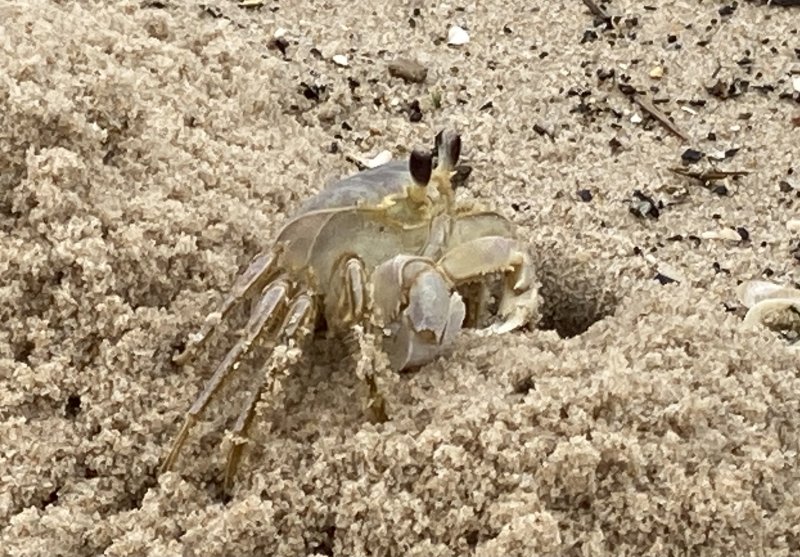Nocturnal natives rule Cape shores from dawn to dusk
A heat mirage in subtle waves of pastels lingers offshore as the summer sun sets. After a day in the blistering heat, the crowd is thinner and the sand is cooler. On higher ground, my territory is marked with a bright red-and-white-striped beach towel. I wiggle my toes in the sand.
Is it an optical illusion? A trick of the fading light? The sand grains appear to be moving, some faster than others. Narrowing my focus, I spy periscope-like eyes that seem to have appeared from nowhere, peeking above excavated holes. Looking, really looking, I see them everywhere! Atlantic ghost crabs embody their Latin name, Ocypode quadrata, which translates as, “swift-footed squares.” Imagine a fast-paced game of capture the flag, with each opposing camouflaged player able to dart to the left, stop abruptly, then fan right, while always looking right at you!
In “Walking Sideways: The Remarkable World of Crabs,” author Judith Weis notes that a ghost crab can cover ground at six feet per second! With compound eyes on movable stalks, each crab has a 360-degree view and can adjust to low light for nocturnal scavenging. As they look for jellyfish, mole crabs, dead fish and turtle eggs, they are aided by the sensilla, tiny structures that support a keen sense of smell.
Add communication to the ghost crab’s list of many talents. Ghost crabs have little bumps (tubercles) on the inner joints of their claws, which they rub against ridges on the front of the first pair of walking feet. Using this action, called stridulation, a male creates a rasping sound to attract a mate. The female has sound or vibration receptors on her legs and may decide to meet her Romeo. To defend a territory, a ghost crab may raise its claws in defense, lift up on its back legs to appear larger, then bang the pure-white crusher claw on the sand. (I saw this action while leaning in for a photo op.) In addition, exciting new research confirms that this species is able to create an audible growling noise to warn off predators. Utilizing X-rays, scientists at the Scripps Institution of Oceanography found the sound and vibrations were produced internally in the gut, or gastric mill, by rubbing the comb-like structures against a “tooth” in the stomach.
The semi-terrestrial ghost crab shares similar physical and life cycle features with the blue crab (Callinectes sapidus). They are both decapods with one pair of chelae, or claws, for scavenging food and four pairs of walking legs. These crabs breathe through their armpits, bringing in water through a chink in their armor to bathe their gills with dissolved oxygen. They have a strong chitin exoskeleton which is shed and re-formed with each growth spurt. The carapace encases a head-thorax region, with the abdomen folded under (picture a lobster tail folded under the body). Segments are visible on the abdomen, with female crabs having a wide appendage with pleopods or swimmerets to hold the developing egg mass (sponge). Eggs are released into the sea each summer and develop in metamorphic stages. The alien-looking planktonic forms of the zoea and megalops larva sport large eyes and spikes, and emerge as miniature adults.
Talk a walk on the beach, looking closely near the wrack line of grasses, shells and detritus. In a ghost crab construction site, numerous burrows closer to the shoreline will have dime-sized holes spaced about 1 1/2-feet apart, while 4 feet or more separate 2-inch burrow entrances above the high-tide line. Each burrow has a pile of sand creating a back rim for a perfect-circle door set with a 45-degree entrance to the interior. Larger crabs, with a 2- to 3-inch carapace, claim locations farthest from the water and closest to the dunes, digging down as much as 4 feet to reach the wet sand. They often plug their entrance shut to stay cool and damp on a hot day. But, how do these land-locked crabs keep their gills moist so far from the water? Ghost crabs are outfitted with fine hairs at the base of their walking legs that “wick” water out of the damp sand and up to their gills using capillary action. With great reluctance, they may return to the water and brace themselves firmly against the swell like a cautious non-swimmer to wet their gills and beat the heat!






















































